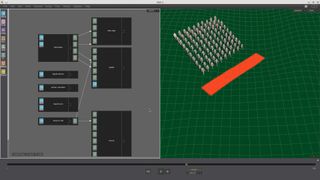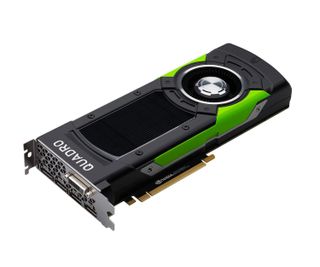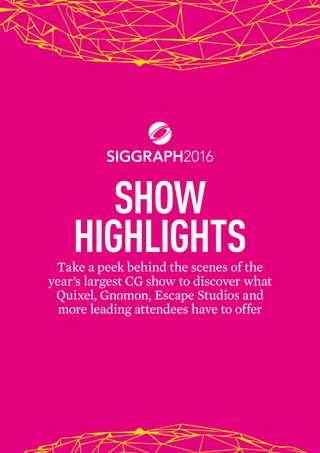The biggest announcements at SIGGRAPH 2016
We roundup all the top news from the most important annual event in computer graphics.
Last week, anyone even remotely interested in the art of 3D, digital art and visual effects gathered for the 43rd annual SIGGRAPH conference, showcasing the latest in computer graphics and interactive techniques. With the tagline 'Render the Possibilities', SIGGRAPH 2016 was held at the Anaheim Convention Center in California, which played host to over 14,000 attendees.
The five-day event saw a number of extraordinary and exciting announcements, which every digital artist should know about. Here's our roundup of the top news from SIGGRAPH 2016...
AI-controlled crowds for 3ds Max
Originally created for use in Peter Jackson's Lord of the Rings trilogy, Massive is a high-end computer animation and AI software package used for generating crowd-related VFX. Now the world's most popular crowd simulation software, the team at Massive have extended its reach by seamlessly integrating it into Autodesk 3ds Max – Massive for Max.
“If you know how to use 3ds Max, Massive will feel like second nature," Massive creator and CEO Stephen Regelous comments. “It is purposefully intuitive, so artists can seamlessly start putting our AI-driven Agents to work right away.
“Massive is the industry leader in crowd simulation software thanks to its AI-controlled software that gives anyone the ability to create film-quality crowds with ease,” says Regelous. “Now 3ds Max users can access the same tools studios all over the world have trusted for years. It should make their lives a whole lot easier.”
Massive for Max is available today on all 3ds Max platforms through a subscription model. Users will be able to subscribe quarterly for USD $595, or annually for USD $1,995. All Massive for Max users will receive a complimentary “Ambient Agent,” which normally sells on its own for USD $3,000.
Plus: Massive simplifies crowd simulation with new Parts Library

The team at Massive had a further annoucement at SIGGRAPH, unveiling a new Parts Library – described by Massive creator and CEO Stephen Regelous as "the single most significant improvement in Massive since it was first released."
Get the Creative Bloq Newsletter
Daily design news, reviews, how-tos and more, as picked by the editors.
The Parts Library provides artists with a new way to build AI-controlled agents. The process, which previously would have taken experienced Massive users days or even weeks to complete, can now be handled by anyone at any skill level in minutes. The AI 'brains' can then be shared over multiple projects.
“Small studios will find this lowers the barrier to generating sophisticated crowd shots, while larger studios will find the Parts Library useful for creating crowd assets that can be shared across multiple Agents as well as multiple projects,” says Regelous.
Pricing/Availability
The Parts Library is available now to all Massive Prime users, who are currently on support and maintenance. Massive Prime 8.1 is priced at USD $16,000 including the first year of upgrades and support.
NVIDIA unveils fastest ever GPU

The world of GPUs got a whole lot more exciting last week at SIGGRAPH when NVIDIA unveiled its new Quadro P6000 – the most powerful graphics card in the world.
Targeted at powerful workstations, used for tasks such as editing HD video and applying special effects, the P6000 has 3,840 cores and 24GB of GDDR5X memory. It supports 432GBps (gigabytes per second) of memory bandwidth. It has four DisplayPort 1.4 slots, supporting resolutions up to 4K at 120Hz and 5K at 60Hz. The GPU has internal pipelines to render faster 3D video.
The NVIDIA website states: "NVIDIA's most powerful GPU architecture ever, the new Quadro products bring a whole new level of performance and innovative capabilities to power visual computing on the desktop, in VR, or on-the-go."
Cinema 4D Release 18 announced

MAXON has announced Cinema 4D Release 18 (R18) at SIGGRAPH 2016, the latest update to its 3D animation, graphics, VFX, visualisation, and rendering software.
The R18 version of Cinema 4D includes several new tools as well as some improvements to existing tools to give creative pros even more power at their fingertips whether they're in digital production for TV, film, games, architecture, advertising or design.
New features and updates include:
- Voronoi Fracture Object – a native feature in the MoGraph toolset in Cinema 4D that works seamlessly with Dynamics, allows users to tear down walls and create artistic procedural geometry using spline or polygon objects to define the fractured shape.
- Interactive Knife Tools – enable users to draw lines across a model and tweak the cut with an interactive preview, then lock in new edges or split based on the cut; knife tools are available as separate commands for easy access to the desired mode via shortcut or Commander.
- Object Motion Tracking – the next evolution in MAXON's effort to give artists accessibility to dynamic VFX and visualization workflows with expanded tools for integrating Cinema 4D creations into real-world footage.
- Shaders and Surface Effects – offer advanced rendering possibilities for creating iridescent surfaces such as bubbles and oil slicks, for capturing shadows for more efficient compositing, parallax mapping for enhanced bump effects, and creating masks for worn edges using inverse ambient occlusion.
- Substance Engine Integration – download compiled Allegorithmic Substances and utilise them to surface your Cinema 4D objects. This fully-integrated implementation offers outstanding workflow and flexibility, plus options to cache Substances on disk for better performance.
Probably the most exciting update is the addition of fracturing, which means an end to the requirement of a plugin for this feature. The new Voronoi Fracture generator is a MoGraph generator and brings full support for effectors and all other MoGraph features, plus it has support for many different point generators (Point Generator, Object, Spline, Particles, MoGraph Matrix, Shader, etc) to define the fracture pattern. You can see it in action in the video below.
For a full list of new and updated features in Cinema 4D R18, head to MAXON's website.
Autodesk unveils Maya 2017
Autodesk showcased all of its latest design animation solutions at SIGGRAPH this year, including Maya 2017 and its new features, such as integrated rendering with Arnold, new motion graphics tools and numerous features and enhancements that aim to help artists work more efficiently than ever.
Maya 2017 includes a full set of mograph tools, which are sure to excite artists. The MASH procedural toolset has been improved with new capabilities allowing designers to quickly create unique animations and motion graphics. A more intuitive UI and enhancements to 3D text tools also means a more efficient workflow for artists.
Now featuring Arnold as its default renderer, this integration of Arnold into Maya 2017 builds on the popular MAXtoA Arnold plugin and brings advanced rendering capabilities within Maya, enabling efficiency, power, ease of use and quality results in a short time.
Full the full list of Maya 2017's extensive toolset, head over to the Autodesk website.
Volumetric VR possible without a game engine

Last week at SIGGRAPH, Nozon and Chaos Group showcased their new technology PresenZ, which enables artists to create pre-rendered, volumetric VR. Using PresenZ and V-Ray, artists can design spaces with free movement and full parallax, without the help of a game engine.
Positional tracking has been a key to immersion for a long time; without it, the presence breaks quickly and the user gets cyber sickness. While game engines have been the standard place to incorporate the 6 degrees of freedom, image quality and scene complexity are very limited. Thanks to this new partnership, artists can use offline rendering to add important movements to their VR, like head motion or walking around inside an image. And because it’s offline, there are no limitations on polycounts or scene density.
“Animators, architects, designers – everyone has a need for immersive VR right now,” said Matthieu Labeau, business development manager at Nozon. “Working with Chaos Group, we’ve been able to bring our technology to the entire V-Ray community, one of the largest user bases of 3D artists in the world. Now everyone has the same opportunity to apply volumetric VR to their 360° movies.”
Bonus: Free SIGGRAPH ebook

Get a little closer to the fun with 3D World's Siggraph sampler! Simply click on the image above to get hold of your free show highlights ebook!
Primary image: Jim Hagarty

Thank you for reading 5 articles this month* Join now for unlimited access
Enjoy your first month for just £1 / $1 / €1
*Read 5 free articles per month without a subscription

Join now for unlimited access
Try first month for just £1 / $1 / €1
The Creative Bloq team is made up of a group of design fans, and has changed and evolved since Creative Bloq began back in 2012. The current website team consists of eight full-time members of staff: Editor Georgia Coggan, Deputy Editor Rosie Hilder, Ecommerce Editor Beren Neale, Senior News Editor Daniel Piper, Editor, Digital Art and 3D Ian Dean, Tech Reviews Editor Erlingur Einarsson, Ecommerce Writer Beth Nicholls and Staff Writer Natalie Fear, as well as a roster of freelancers from around the world. The ImagineFX magazine team also pitch in, ensuring that content from leading digital art publication ImagineFX is represented on Creative Bloq.
